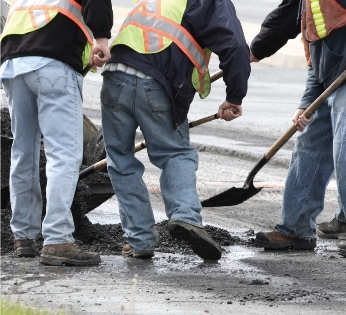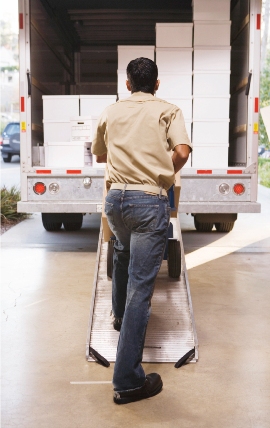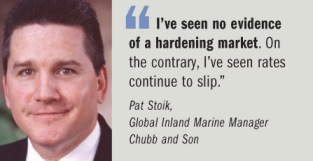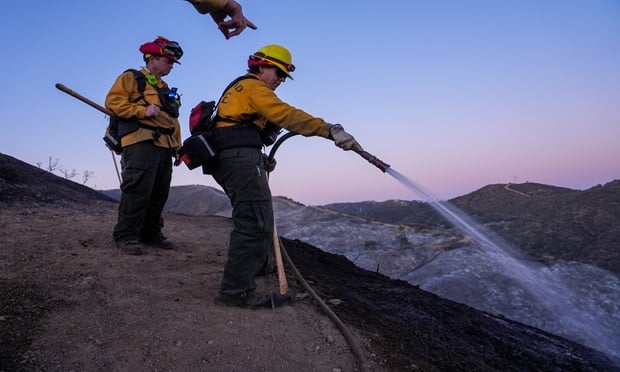For the two major inland marine lines, construction and trucking, the challenges that have faced the marketplace for the last two years–the economic downturn, along with stubbornly soft insurance pricing–continue to spur intense competition for a shrinking exposure pie, with little hope for a quick turnaround.
Has the federal stimulus package helped revive the construction sector? Somewhat. Is the residential construction market recovering? Not really. Is the steady stream of new entrants into the marketplace continuing or leveling off? Depends on who you talk to.
For contractors in the construction segment, Mike Berg, who ov ersees Allianz Global Corporate and Specialty's inland marine operations, said the situation has changed very little. “They continue to be impacted by the economy,” he said.
ersees Allianz Global Corporate and Specialty's inland marine operations, said the situation has changed very little. “They continue to be impacted by the economy,” he said.
Joseph Tracy, president of Travelers inland marine, said there has been some improvement in construction, but that is measured against “very depressed 2009 and late 2008 figures.”
For residential construction, Mr. Tracy said there are some signs of recovery. In fact, he said the residential side was the first to take a hit in the economic downturn, and is the first to be rebounding.
Small residential jobs remain “hard to come by,” according to Mr. Berg. They are out there, he noted, but are not common.
He said there is some positive activity in larger residential projects, but he noted that so many properties are in foreclosure, the individual real estate market will probably not pick up until those dwellings get absorbed somehow.
Banks, Mr. Berg said, are attempting to take action to reduce the number of foreclosed dwellings while still keeping people in their homes.
J. Barry May, vice president, marine, for Acadia Insurance, which writes risks in New England, said that “from our vantage point, residential construction is beginning to show an increase, albeit at a slow pace and limited to single projects rather than housing developments or speculative building.”
But Ron Thornton, president of the Inland Marine Underwriting Association–which holds its annual meeting this week in Williamsburg, Va.–was blunt when talking about the residential market, which he said has “collapsed.” He noted there is talk of some pickup in regions that were not severely affected by the recession, but said he hasn't seen a change.
Pat Stoik, vice president and global commercial inland marine manager at Chubb and Son, agreed, saying the residential market “has not come back.”
He said the market has been hot and cold, making it difficult to determine which way residential construction is heading. Starts are up one month, he said, and then down again the next. He said he has not seen any one region being better or worse than others.
On the commercial side, Mr. Tracy said public infrastructure projects “have seen a positive boost and are rebounding somewhat,” but noted the private commercial sector is still struggling. Private commercial projects may improve, he said, as credit becomes more accessible.
Mr. Stoik said infrastructure projects have seen some positive impact from the federal stimulus package, citing waste-water treatment projects and road infrastructure as areas where construction activity has picked up. The number of opportunities seems to be increasing at a noticeable, if not dramatic, pace, he added.
While acknowledging that the stimulus bill has helped with some infrastructure projects, IMUA's Mr. Thornton said not a lot of money, as far as he knew, went to constructing buildings.
Mr. Thornton said there has been talk of private/public partnerships that will take up projects that have been abandoned, such as office towers and apartment complexes. He noted this might involve new companies and/or contractors than those previously on the projects.
But Mr. Thornton said public infrastructure is likely to be where a turnaround in commercial construction will come from–with projects such as fixing roads and building prisons. “I think that's where [a recovery is] going to come from more so than XYZ company building a new tower or building.”
Summing up the state of this sector, Acadia's Mr. May said that “new commercial construction remains virtually nonexistent. Most commercial work appears to involve renovation or rehabilitation projects. We are seeing a degree of municipal work, as well as street and road construction, too.”
Ultimately, though, Mr. Thornton said the economy needs to substantially improve before there is an increase in construction.
For trucking companies, much depends on improvement in the economy as well. As such, experts said there have been some signs of improvement for truckers, but generally, as Mr. Stoik said, “they're still limping along,” with no dramatic shifts in the marketplace.
Mr. Berg summed up the issues facing truckers, saying manufacturers are making fewer goods to sell because they expect reduced sales, so consequently there are fewer goods for truckers to carry.
As with construction, Mr. Berg said trucking companies consist of a lot of owner/operators who will continue to be significantly impacted if the economy doesn't improve.
Speaking to some positive signs, Mr. Thornton said freight revenues were up for the second month in a row in March–the first time this has happened in the last 14-16 months.
What do the continued struggles in construction and trucking mean for inland marine insurers? With soft market conditions prevailing, experts said carriers are still fighting on price for less available premium.
“It's only gotten more intense from a competition standpoint,” said Mr. Stoik.
All experts agreed that pricing remains competitive, and none would predict when a harder market might begin to take hold.
Mr. Stoik said, “I've seen no evidence of a hardening market. On the contrary, I've seen rates continue to slip.”
Speaking to the trucking segment, Rebecca McNabb, trucking transportation manager for Burns and Wilcox in Indianapolis, said pricing has reached “desperate levels,” adding that some carriers have to be experiencing adverse loss ratios because of it. Historically speaking, she said, trucking cannot remain profitable for insurers at the current pricing levels.
Some offered ideas on what it would take for the market to change, with Mr. Thornton suggesting some severe catastrophes might alter insurer attitudes on price, and Mr. Berg wondering whether the market can improve given the state of the economy today.
With the continuing decline in available risks, why are insurers so interested in construction and trucking? According to Mr. Thornton, there are 32 different classes of inland marine risks, but construction and transportation are the two biggest. And with all of the publicity continuing to indicate that these lines are profitable–with a combined ratio of 80–he said insurers become attracted to these lines.
But pointing to the lack of new risks available in these sectors, Mr. Thornton said of newer players, “the person that's pursuing that pie is getting someone else's renewal.”
Mr. Thornton said he is continuing to see new entrants enter the market, stating that he knows of three companies in various phases of startup operations since the first of the year.
Mr. Berg seconded that motion. “We continue to see new entrants come into the inland marine field,” he said.
Yet others pointed to a slowing in the number of new entrants over the past year. Mr. Stoik said there was a large influx about a year ago, but the pace has slowed this year. He said now the new entrants from a year ago are “getting their feet on the ground” and going after business.
Travelers' Mr. Tracy, speaking for the construction segment, gave a similar answer regarding new entrants, as did Sam Rizzitelli, portfolio director for Travelers Inland Marine's transportation business, speaking for the trucking segment.
Both Mr. Tracy and Mr. Rizzitelli used the same word for why the number of new entrants has fallen off–saturation.
Going forward for insurers, the experts said the strategy is to ride out the economic and soft insurance market realities by maintaining a good level of service and maintaining underwriting integrity.
On the construction front, Mr. Tracy said with fewer projects, his company can visit more sites, which helps from a loss control perspective.
For trucking, Mr. Berg and Mr. Rizzitelli mentioned taking more measures to battle the growing problem of cargo theft.
Mr. Berg referenced the importance of insurance carriers being involved with innovative initiatives like CargoNet, a national information sharing system that combats cargo crime.
Mr. Rizzitelli said there has been an increase in cargo theft, with a shift in the types of goods being stolen. He said there are more thefts of food and beverages from trucks, and that may be due to such items representing a higher percentage of what is being shipped relative to years past.
Mostly, experts talked about being consistent during the tough times.
“I'm making sure our underwriters have the support to be smart underwriters, price risks accordingly, give them tools to be efficient [and] allow them to do their job in a better fashion,” Mr. Stoik said. “That's our strategy.”
Want to continue reading?
Become a Free PropertyCasualty360 Digital Reader
Your access to unlimited PropertyCasualty360 content isn’t changing.
Once you are an ALM digital member, you’ll receive:
- Breaking insurance news and analysis, on-site and via our newsletters and custom alerts
- Weekly Insurance Speak podcast featuring exclusive interviews with industry leaders
- Educational webcasts, white papers, and ebooks from industry thought leaders
- Critical converage of the employee benefits and financial advisory markets on our other ALM sites, BenefitsPRO and ThinkAdvisor
Already have an account? Sign In Now
© 2025 ALM Global, LLC, All Rights Reserved. Request academic re-use from www.copyright.com. All other uses, submit a request to [email protected]. For more information visit Asset & Logo Licensing.








